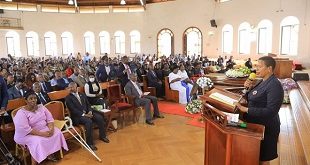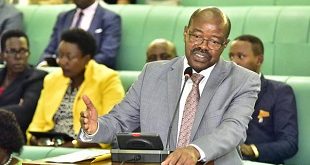-consults-with-Dr.-Peter-Blomeyer,-the-German-Ambassador-to-Uganda-during-the-Joint-Sector-Review-on-Oct.gif)
Prof. Ephraim Kamuntu, the Minister of Water and Environment has advised the government to prioritize the water and environment sector if the country is to maintain its high economic growth.
Kamuntu was on Oct. 21 delivering a key note speech entitled, “Bridging the Gap,” during the launch of the sixth joint water and environment sector review at Munyonyo Commonwealth Resort Hotel on the outskirts of Kampala.
The joint sector review brings government, donors and the private sector together every year and is intended to evaluate the sector’s physical and financial performance.
It is also aimed at looking at the progress, challenges and operational issues facing the sector so that the players can agree on the implementation of planned activities in the new financial year.
Kamuntu noted that out of the 17 sectors, water and environment is still at the bottom of priorities for the government in terms of funding yet this sector is the engine of Uganda’s economic growth.
Reacting to this year’s joint review theme, “Financing of the Water and Environment Sector for Sustainable Service Delivery,” Kamuntu said the funding for the sector is still low and there has been a decline in the sectoral budget share from 3.2% in 2013/14 to 2.3% for 2014/15.
According to Dennis Ocare, the Assistant Commissioner, Policy and Planning, at the Ministry of Finance, the water and sanitation sector required Shs1.019 trillion this financial year but received Shs 427.8b leaving a funding gap of Shs 591.1b while the environment and natural resources sector needed Shs 108 b but received 97.3b, leaving a funding deficit of 10.4b
Kamuntu said unless government realizes that water is the ultimate resource for Uganda’s economy, the country may be planning to fail.
The government is in advanced stages of preparing the second national development plan (NDP) to cover the next five years [2015/16—2019/20]—a blueprint which is supposed to contribute to the achievement of Uganda’s Vision 2040 which aims to transform the country from a predominantly peasant and low income country to a competitive, upper middle income country.
“We may plan for infrastructure but unless we properly plan for our water resources, we may be planning to fail,” he said.
In this year’s State of the Nation address, President Yoweri Museveni identified the areas of agriculture, industry, services and ICT as key in the creation of wealth and access to employment for Ugandans over the coming years.
However, Kamuntu said the performance of these key sectors is premised largely on the performance of the water and environment sector.
He said there is no doubt that the water and environmental sector has done well in recent years but more still needs to be done to ensure that 100% of the country gets clean and safe drinking water.
Commending the sector for contributing ‘tremendously’ to Uganda’s achievement of both MDGs and national development goals, Kamuntu said the government will never rest until all Ugandans get access to clean and safe drinking water.
“The performance has been quite impressive but still there is a lot to be done,” he said.
As of June 2014, the population with access to safe water in urban areas was 72.8% while the rural population with access to safe water remained stagnant at 64%.
This is mainly attributed to the inadequate funding to the district local governments that have the responsibility for water and sanitation service provision.
The national household latrine coverage has improved from 71% to 74.8% while hand washing with soap after toilet use has improved from 29% to 32.8%.
Kamuntu noted that still no Ugandan should walk beyond 1km to access safe water in rural areas and in urban areas, that distance should not exceed 0.2km.
“Our target is to have 100% of Ugandans access clean safe water. If we have not yet achieved this, then this shows the challenges we still have,” he said.
Going forward, in order to stop the water and environment sector being taken for granted, Kamuntu said his ministry and the World Bank will soon undertake a study to assess and cost the contribution of the water and environment sector to Uganda’s economic growth.
“Part of the reason the sector is underfunded is because they [government technocrats] don’t see numbers. The study must show the contribution the sector is making to the economic growth of Uganda,” he said.
He added that besides encouraging tree-planting to restore the country’s forest cover, the ministry is also going to emphasize rain water harvesting.
“There are millions of Ugandans with corrugated iron-roofed houses and these must be harnessed,” he said.
Florence Adongo, the Commissioner in charge of water quality at the water and environment ministry said Uganda’s water resources have recently been quantified in terms of availability and demand.
She said the total annual renewable water resources of Uganda have been estimated to be 43 cubic kilometres and out of this, 29 cubic kilometres are externally renewable water resources and 14 cubic kilometres are internally renewable water resources.
However, Uganda’s dependence ratio on water resources originating from outside its borders is about 69%.
She further noted that while Uganda is still fairly well endowed with water resources, the resources are not evenly distributed, both in space and time implying that some areas have too much water that may lead to floods while some areas have too little water that may lead to water scarcity.
Adongo added that in recent years, there has been a general reduction in water resources and increase in pollution of water resources at local level due to environmental degradation, poor land use practices discharge of untreated effluent.
Kamuntu challenged the notion that Uganda is well-endowed with water resources, arguing that in the coming years, Uganda’s population boom and climate change will stretch those resources.
He called on Uganda’s engineers to invent design appropriate technologies that can address the demands of local Ugandans.
He said the functionality of water sources is still a big issue because investments are going to waste due to lack of maintenance mechanisms.
 The Independent Uganda: You get the Truth we Pay the Price
The Independent Uganda: You get the Truth we Pay the Price


